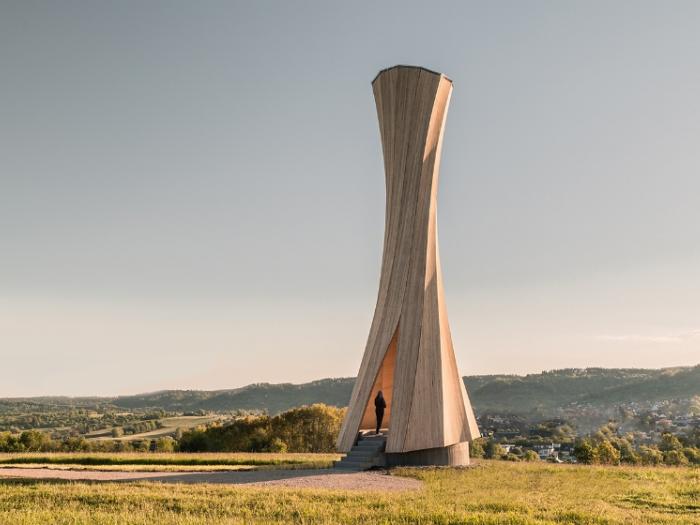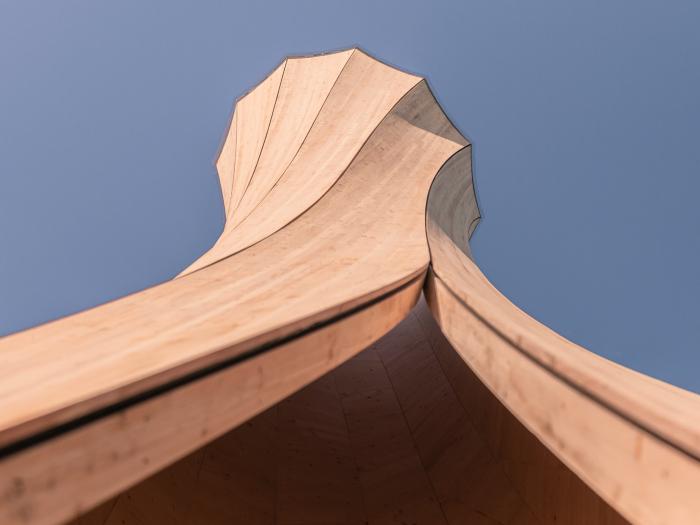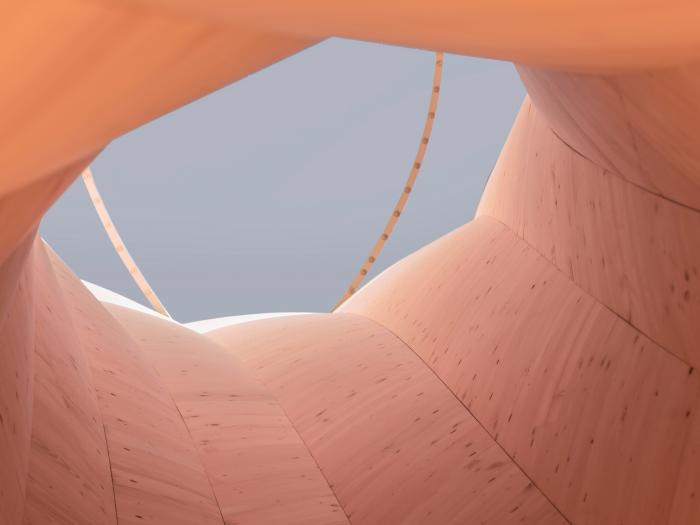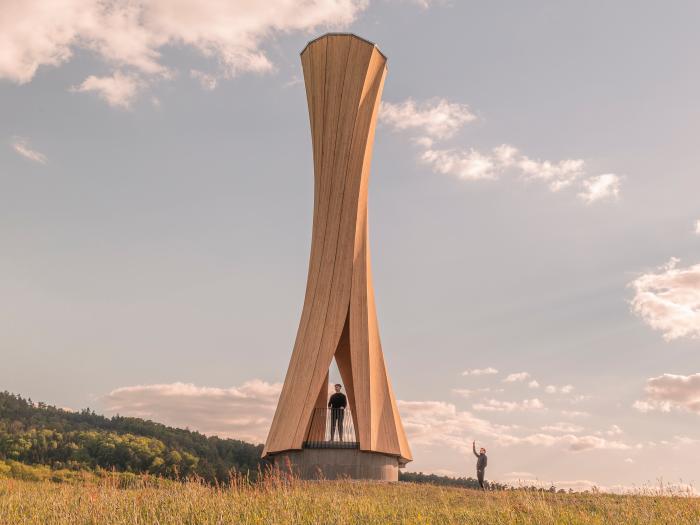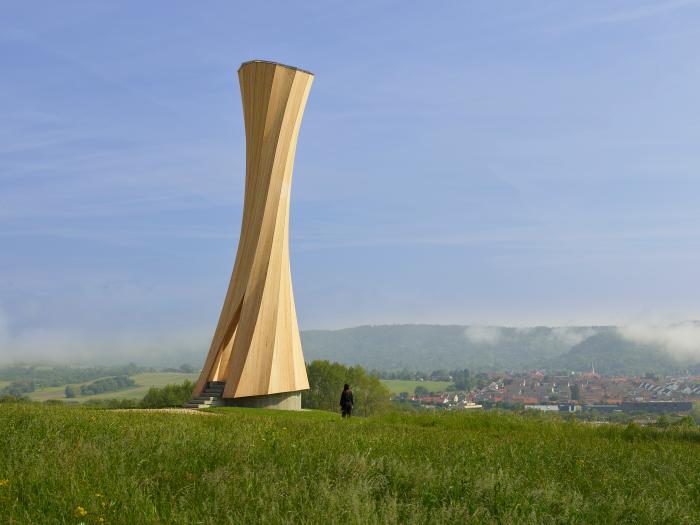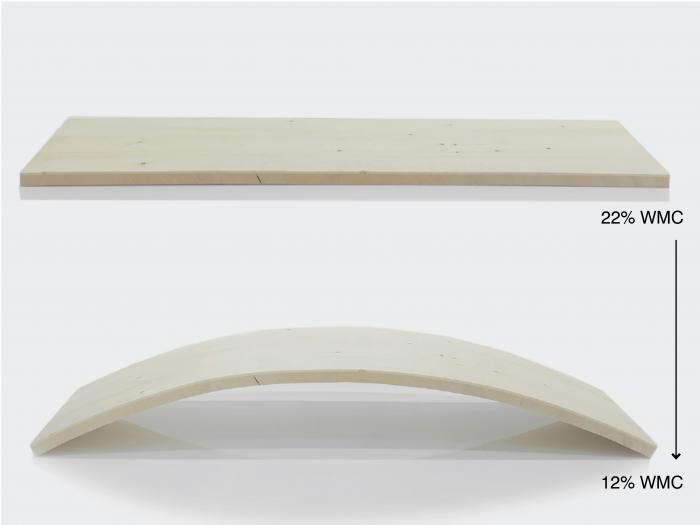I. SUMMARY INFORMATION
Project
268138
Status
Submitted
Award category
Techniques, materials and processes for construction and design
You want to submit
NEW EUROPEAN BAUHAUS AWARDS : existing completed examples
Project title
Urbach Tower
Full project title
Urbach Tower - Innovative Self-shaping Manufacturing of High Performance Curved wood Architecture
Description
The Urbach Tower is a unique wood structure. The design of the tower emerges from a new self-shaping process of the curved wood components. This pioneering development constitutes a paradigm shift in timber manufacturing from elaborate and energy-intensive mechanical forming processes that require heavy machinery to a process where the material shapes entirely by itself This shape change is driven only by the wood’s characteristic shrinking during a decrease of moisture.
Where was your project implemented in the EU?
Germany
Baden-Wurttemberg
RH38+34
48_48_10.1_N
9_33_54.4_E
Urbach
73660,
When was your project implemented?
Has your project benefited from EU programmes or funds?
No
Which programme(s) or fund(s)? Provide the name of the programme(s)/fund(s), the strand/action line as relevant and the year.
II. DESCRIPTION OF THE PROJECT
Please provide a summary of your project
The Urbach Tower is a unique landmark built from self-shaping wood for the Remstal Gartenschau 2019 in Urbach, Germany. The design of the tower emerges from a new self-shaping process of the curved wood components. This pioneering development constitutes a paradigm shift in timber manufacturing from elaborate and energy-intensive mechanical forming processes that require heavy machinery to a process where the material shapes entirely by itself. This shape change is driven only by the wood’s characteristic shrinking during a decrease of moisture content. Components for the 14 m tall tower are designed and manufactured in a flat state and transform autonomously into the final, programmed curved shapes during industry-standard technical drying. This opens up new and unexpected architectural possibilities for high performance and elegant structures, using a sustainable, renewable, and locally sourced building material. The Urbach Tower constitutes the very first structure worldwide made from self-shaped, building-scale components. It not only showcases this innovative manufacturing approach and resultant novel timber structure; it also intensifies the visitors’ spatial involvement and landscape experience by providing a striking landmark building for the City of Urbach’s contribution to the Remstal Gartenschau 2019.
Please give information about the key objectives of your project in terms of sustainability and how these have been met
The self-shaping components are made entirely of spruce wood boards sourced regionally from Switzerland. Individual components span up to 15 m with a radius of 2.40 m and a structural thickness of only 90 mm. The components are 5-Axis CNC cut and detailed from half cylinder blanks and pre-assembled into building groups of three components for transport, including water barrier and external wood cladding. With precise curvature and optimal fiber alignment from the manufacturing process, each component is cut in detailed in just 90 minutes of machine time. A custom-made protective cladding layer consisting of glue laminated larch wood is added on the outside. This also includes the application of a transparent and durable inorganic coating, which protects the wood from UV radiation and fungi attack. Instead of ripping and turning silver-grey when exposed to outdoor weathering, the larch wood will take on an even white color over time. The entire process chain, from cutting regional logs in the sawmill to the production of the self-shaping panels, the drying process and final machining and pre-assembly takes place within the same group of companies and at the same location. This not only allows for sustainable and innovative production, but it also shows, how the self-shaping manufacturing can seamlessly integrate in established industrial wood processing and manufacturing workflows.
Please give information about the key objectives of your project in terms of aesthetics and quality of experience beyond functionality and how these have been met
The Urbach Tower is one of 16 stations designed by some of the most renowned German architects for the Remstal Gartenschau 2019. The stations are small, permanent buildings that evoke the traditional white chapels distributed in the fields and vineyards along the scenic Rems Valley. Located on a prominent hillside in the center of the valley, the 14 m tall tower is a striking landmark that visually connects several stations. It provides a place of shelter, internal reflection and outward view by revealing stunning vistas and framing the landscape. The distinctive form of the tower constitutes a truly contemporary architectural expression of the traditional construction material wood. It celebrates the innate and natural characteristics of self-shaped wood in its upwards spiraling shape. The concave curvature of the structure on the outside results in sharp lines and crisp surfaces, which is further accentuated by direct day light and whitening of the larch cladding over time. In contrast, on the interior the convex curvature creates an unexpected visual and tactile material experience, with the timber structure appearing to be almost soft and textile-like, highlighted by the light washing the gently undulating surfaces. Opposite the entrance, the thin wood envelope opens like curtain, putting the Rems Valley on center stage.
Please give information about the key objectives of your project in terms of inclusion and how these have been met
Two key objectives in relation to inclusion have been addressed for the Urbach Tower project. First, in a tangible way the building represents an open an accessible demonstration of research and architecture. The build is a permanent structure, entirely open to the public. In this way it is designed and situation to live within the inclusive public realm and the natural landscape. As a landmark it also stands proudly as a visible expression of the potentials for sustainable construction of the future. In addition to its physical openness the project has been widely exposed digitally creating an international online presence. Second, as an outlook the self-shaping wood concept is envisioned to enable the shaping of performative geometry without complex machines and infrastructure. While it is so far shown in an advanced factory setting, future goals aim to develop the concept in a way that it can be more easily implemented in more diverse context allowing for easier generation of good geometry and structure for building components. As the shaping is driven by the material this dissemination should be achievable across a range of social economic settings, geographic areas and wood species!
Please give information on the results/impacts achieved by your project in relation to the category you apply for
The pioneering development of large-scale self-shaping constitutes a paradigm shift in timber manufacturing from elaborate and energy-intensive mechanical forming processes that require heavy machinery to a process where the material shapes entirely by itself. This shape change is only driven by the wood’s characteristic shrinking during a decrease of moisture content. The curved Cross Laminated Timber (CLT) components for the tower’s structure are designed and produced as flat panels that deform autonomously into predicted curved shapes when dried. The 5.0 m x 1.2 m spruce wood bilayers parts are manufactured with a high wood moisture content and specific layups and dried in an industry standard technical drying process. When removed from the drying chamber the parts are precisely curved. The parts are overlapped and laminated together to lock the geometry in place, forming larger curved CLT components with form stable geometry. Material specific computational mechanics models have been developed to both design, predict, and optimize the material arrangement required to produce different curvature types and radius. The technology of self-shaping manufacturing for solid timber boards and the rapid adaptability of the process to different curvatures open up new and unexpected architectural possibilities for thin shell wood structures, using a sustainable, renewable, and locally sourced building material. The Urbach Tower is the very first implementation of this technology on building-scale, load-bearing timber parts.
Please explain the way citizens benefiting from or affected by the project and civil society have been involved in the project and what has been the impact of this involvement on the project
The project is a public building situated in a natural rural setting and was commissioned by the local municipality of Urbach. The municipality was involved in all stages of the planning and design of the project, most specifically with selecting a suitable site which would provide access and visibility without compromising the character and nature of the village. The impact of these considerations is visible in the local popularity of the project and range of visitors from locals that frequent the tower for daily walks to international visitors. The main access to the building is by foot or bicycle promoting healthy activities and cleaner means of short distance transport. Despite its small footprint the building provides a comforting place of relaxation and reflection while creating a unique framing of the natural landscape and sky.
Please highlight the innovative character of the project
In timber construction, moisture typically causes problems with cracking and deformation; hence, moisture changes and stress development must be carefully controlled. In contrast, in this project wood is programed and arranged in a way to utilize this powerful, naturally occurring deformation to trigger a designed self-shaping behavior. In the same way that machines can be programmed to perform different movements, wood parts can be programmed to transform into predetermined shapes when dried. While methods of bending wood into different shapes for structure and aesthetics have existed for centuries and have become recognized industrial processes, they still mostly rely on brute mechanical force for the shaping process. Similarly, an understanding of how wood deforms due to changes in moisture content is well known in practice and academics. However, a shift in design thinking, as well as new computational simulations for more accurate prediction, now allow us to use this moisture induced swelling and shrinking to design and program specific self-shaping movements at larger and larger scale.
Please explain how the project led to results or learnings which could be transferred to other interested parties
The project has led to transferable results in technical manufacturing, wood science and architecture. On a technical level the self-shaping manufacturing is of particular interest to the timber industry for further investigations for shaping both smaller and larger components. More specifically for curved geometries in roof structures, load bearing walls, masts and columns that would serve as lightweight alternatives to less sustainable materials such as steel, reinforced concrete and or composite. These results are transferred through continued R+D in the public realm. In architecture the results of the project show the aesthetic and efficiency that can be achieved through sustainable design and construction. This is transferred through international publications, presentations and a TEDx talk!
Is an evaluation report or any relevant independent evaluation source available?
No
III. UPLOAD PICTURES
IV. VALIDATION
By ticking this box, you declare that all the information provided in this form is factually correct, that the proposed project has not been proposed for the Awards more than once under the same category and that it has not been subject to any type of investigation, which could lead to a financial correction because of irregularities or fraud.
Yes
